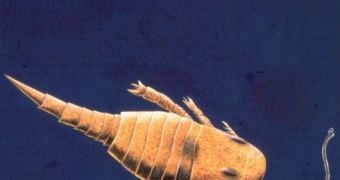In an isolated region in South Africa, there is a remote place very rich in fossilized remains, which have been extremely well preserved for the past half a billion years, and a team of geologists from the University of Leicester’s Department of Geology, found out how did all these fossils get there.
Their explanation is very simple: an ancient glacial wind brought the region to life, only to kill every living being afterwards and help preserve the remains.
Jan Zalasiewicz, Sarah E. Gabbott and Richard J. Aldridge from the Department of Geology, University of Leicester, along with Johannes N. Theron (Department of Geology, University of Stellenbosch, South Africa), examined a site close to the Table Mountains in South Africa.
Sarah Gabbott explained that “near Table Mountain in South Africa lies one of the world’s most mysterious rock layers.
“Just a few meters thick, and almost half a billion years old, it contains the petrified remains of bizarre early life-forms, complete with eyes and guts and muscles.
The researchers noted that this place, an exceptional fossil preservation deposit in South Africa, is a key early Paleozoic Lagerstätte (a sedimentary deposit that exhibits extraordinary fossil richness or completeness) that contains glacigenic deposits of the Late Ordovician glacial peak period.
Gabbott added that they “investigated why these animals are so marvelously preserved, when most fossils are just fragments of bone and shell.
“The answer seems to lie in a bitter wind, blowing off a landscape left devastated by a massive ice-cap.”
Funding from the Royal Society allowed Gabbott and Zalasiewicz to use a special 'Petroscope' and make a microscopic analysis of the shale layer.
This revealed extraordinary and unique structures, like myriads of silt grains, 'carefully' wrapped in the remains of marine algae.
The authors explained that “the silt grains are sedimentary aliens - much bigger than the marine mud flakes in which they are embedded.
“They could only have been blown by fierce glacial winds on to the sea surface from that distant landscape.
“Arriving thick and fast, they carried nutrients into the surface waters, fueling its prolific life.
“The deep waters, though, were overwhelmed by rotting, sinking vegetation, becoming stagnant and lifeless – ideal conditions to preserve the animal remains, down to their finest details.
“A cold wind, here, was key to both life and death,” AlphaGalileo quotes.
Their results of their research so far, are published in the latest issue of the journal Geology.

 14 DAY TRIAL //
14 DAY TRIAL //